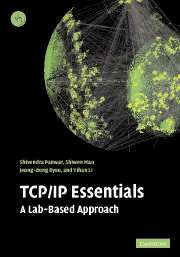Book contents
- Frontmatter
- Contents
- Preface
- Acknowledgements
- General conventions
- List of abbreviations
- 0 TCP/IP overview
- 1 Linux and TCP/IP networking
- 2 A single segment network
- 3 Bridges, LANs and the Cisco IOS
- 4 Static and dynamic routing
- 5 UDP and its applications
- 6 TCP study
- 7 Multicast and realtime service
- 8 The Web, DHCP, NTP and NAT
- 9 Network management and security
- References and further reading
- Appendix A Instructor's guide
- Appendix B Initial configuration of the routers
- Appendix C Source code
- Appendix D List of key requests for comments (RFC)
- Index
4 - Static and dynamic routing
Published online by Cambridge University Press: 05 June 2012
- Frontmatter
- Contents
- Preface
- Acknowledgements
- General conventions
- List of abbreviations
- 0 TCP/IP overview
- 1 Linux and TCP/IP networking
- 2 A single segment network
- 3 Bridges, LANs and the Cisco IOS
- 4 Static and dynamic routing
- 5 UDP and its applications
- 6 TCP study
- 7 Multicast and realtime service
- 8 The Web, DHCP, NTP and NAT
- 9 Network management and security
- References and further reading
- Appendix A Instructor's guide
- Appendix B Initial configuration of the routers
- Appendix C Source code
- Appendix D List of key requests for comments (RFC)
- Index
Summary
We hoped that we could find a way to permit an arbitrary collection of packet-switched networks to be interconnected in a transparent fashion, so that host computers could communicate end-to-end without having to do any translations in between.
Vinton G. CerfObjectives
Comparison of router and bridge.
IP forwarding.
Use of ICMP messages in routing.
The Routing Information Protocol (RIP).
The Open Shortest Path First (OSPF) protocol.
Static routing by manually building the routing tables in the routers and hosts.
Use of Traceroute to find an end-to-end route.
Static and dynamic routing
Routing is the act of transferring packets from a source to a destination using network layer protocol information. It involves two activities, determining optimal routing paths and transporting packets through an internetwork. The key to these two activities is the routing table maintained in each host and router. The routing table records optimal routes and is consulted when a forwarding decision is to be made for an arriving packet. The routing table can be manually set, updated by an ICMP message received, or by routing daemons implementing dynamic routing protocols.
Next-hop routing
When a host needs to send a packet to a destination, it uses its own netmask and the IP address of the destination host to find out the network and subnet ID (or the extended prefix) of the destination.
- Type
- Chapter
- Information
- TCP/IP EssentialsA Lab-Based Approach, pp. 77 - 99Publisher: Cambridge University PressPrint publication year: 2004



